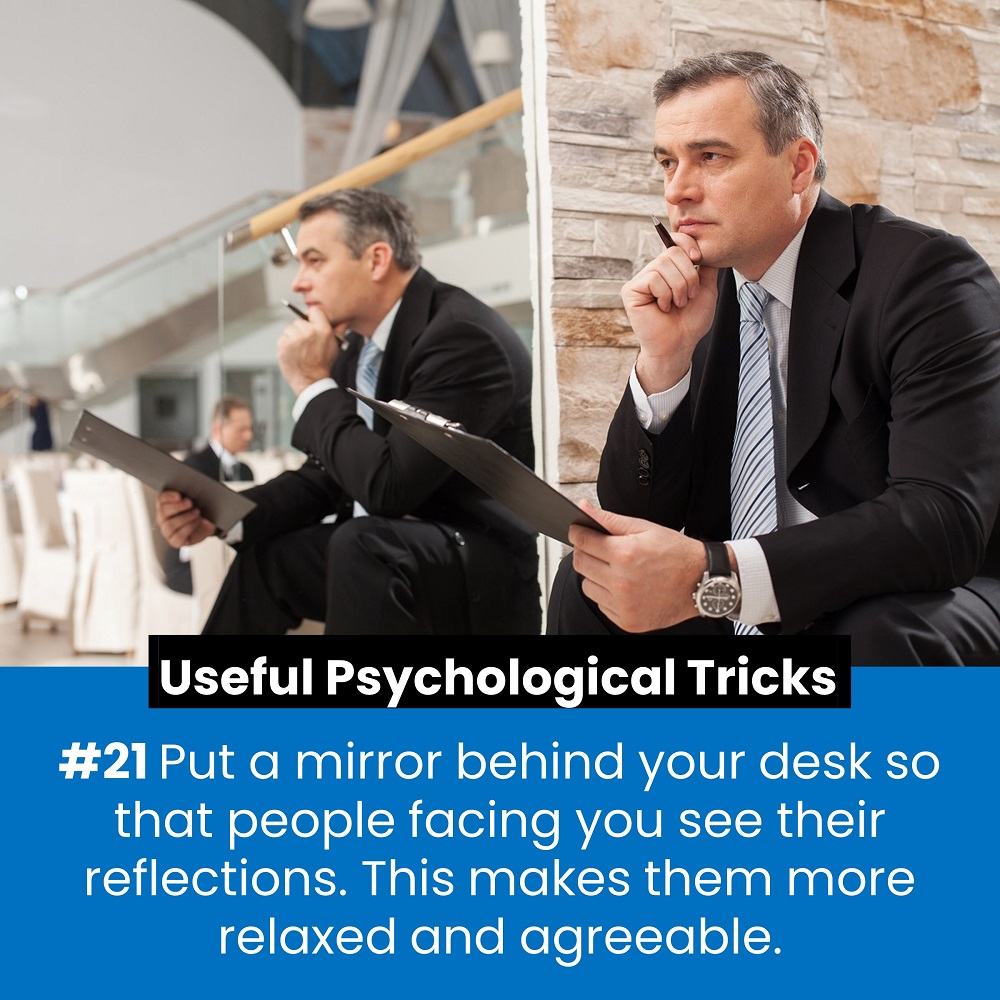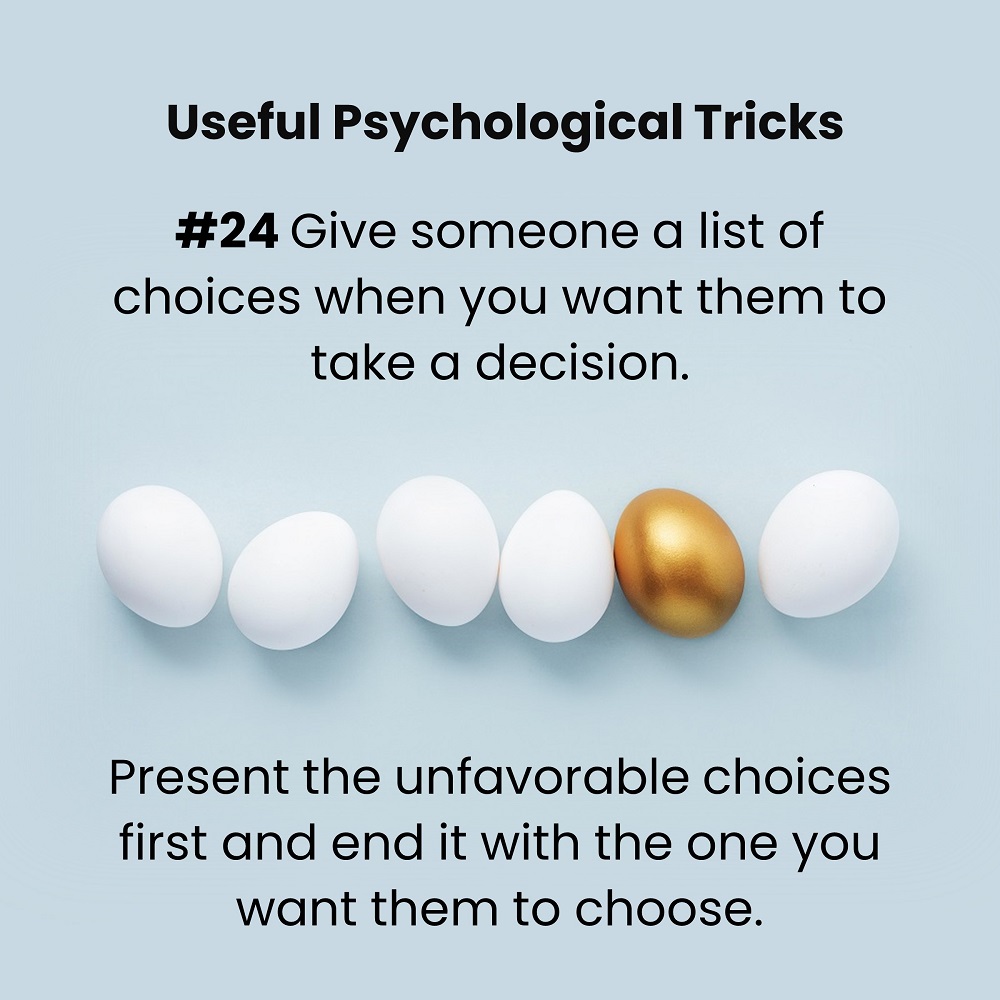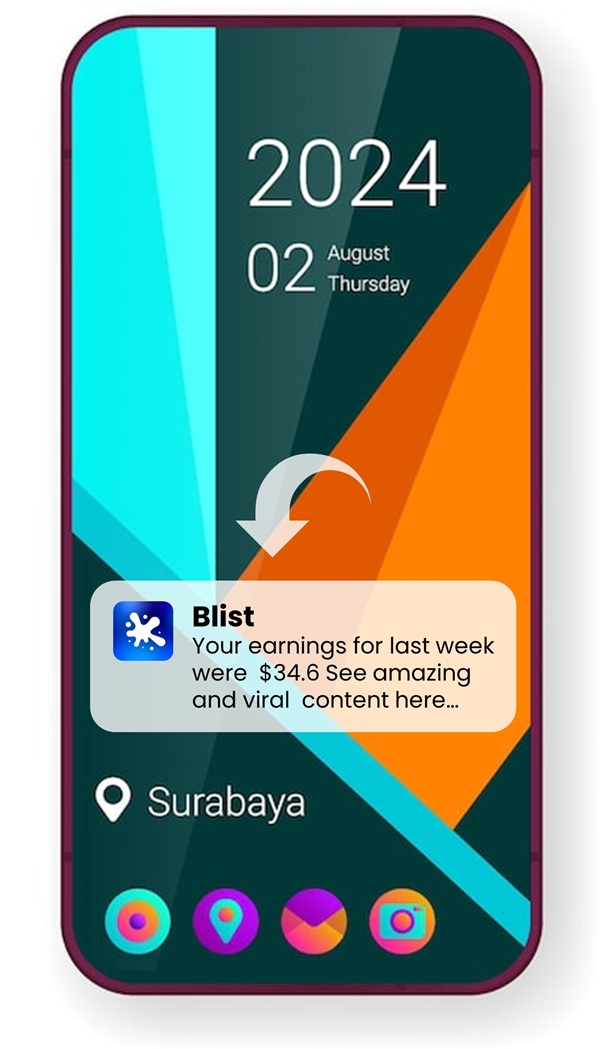24 Psychological tricks to control and manipulate others 😈👹
-
1. Take a really profound book with you to a job interview

They say that you can truly know someone by the books they read.
Bring a profound book to a job interview that you think will impress others or portray a particular image about you in their mind.
Pretend to be reading the book while you are waiting for your turn.
I myself have used this trick with success. More often than not, the interviewer will ask you about the book, which will turn into a great conversation leaving a different and memorizable impression of you in the interviewer's mind.
-
2. Admit unimportant secrets or mistakes to others

Establish rapport and trust with people around you by revealing a carefully selected mishap, mistake, or secret.
Your ability to confess, even if it is insignificant, shows that you are a transparent and honest person.
The after-effects of this are that others will trust you more and will open up to you about their secrets and own mistakes.
This trick works equally well at professional or personal levels
-
3. Say no without a reason

Most people feel inclined to give a justification when they are about to decline or refuse something.
The justifications are usually either lies or reveal unnecessary information about them.
The next time you say no to someone, just say "No" and stop right there.
-
4. Relationships through explanations

Build a relationship with someone by asking them to explain something to you.
The more passionate they are about the topic the better the results.
People like people who are attentive to their interests.
-
5. "Please" instead of "Could you"

Start your request with "Please" instead of "Could you".
"Please" has a more direct effect and makes others think less about whether the request should be fulfilled.
"Could you" is an affirmative question with possible "Yes" or "No" answers.
Don't give others the opportunity of declining your request.
-
6. Challenge others to things

Tell someone that they can't do something if you really want them to do it. This trick may not work on everyone so you have to use it intillegently. Many people like challenges and love to prove others wrong. If you tell them that can't do something, they will do it.
-
7. "Start" instead of "Do"

Use the word "Start" instead of "Do" to get things done.
"Start" has timing implied in it and that time is now. It embeds a sense of urgency that pushes people to actually embark on the task right away.
"Do" on the other hand has no sense of urgency attached to it, which leaves an open window for people to react.
-
8. Lower people's expectations

Lower people's expectations by telling them that "you will try to do it" not "I will do it". When you say that you will try people will be more accepting if you failed and appreciative if you succeeded.
-
9. Use leverage wisely

If you catch someone doing something wrong or unacceptable, don't expose them or threaten them, on the contrary, tell them that their secret is safe and that no one will know about this.
This is called leverage and it will ensure that the other person remains within your control and influence.
-
10. Bystander effect

The "bystander effect" is a social concept that attempts to explain why people are less likely to react when they are in a group than when they are alone.
An example of this is someone who is injured and needs help in a public place full of people. Everyone will be looking at the injured person waiting for someone else to approach and offer help. Probably no one is going to help that person because everyone is waiting for someone else. But if you are the only one next to that person you will immediately offer help as there is no one else to do it.
So how can the "bystander effect" be taken advantage of?
Well, let's say that you are a manager and you want your team to work together on some project.
Meet each member of your team individually and ask them to work with others on the project. Once you have met with each one, have a group meeting with the whole team announcing the project.
Because you had individual meetings with each person, everyone will feel responsible for the success of the project because they know that they can't blame others. You specifically gave that responsibility to them.
-
11. In meetings, sit next to your boss

In meetings sit next to the person who hates you the most, the most aggressive, or your boss.
This will reduce the level of confrontation between you and them because people are less likely to attack people sitting next to them (on their side) than someone on the other side of the table. Spare yourself some public criticism.
-
12. Ask for more than what you want

Always ask for more than what you actually want to get what really want.
This ancient negotiation technique is often overlooked by people, which leads to a loss.
Raise the bar as much as you can. Compromises will happen for sure and when they happen you should at least get your bottom-line gains.
-
13. Ask a question and remain silence

Ask someone a question and remain silent even after they have answered your question.
The fact that you remained silent is a sign that you expect more.
The awkward silence makes most people very uncomfortable that they will probably continue to talk and provide more information than they intended to give.
-
14. Use pauses

People feel very uncomfortable with pauses in a conversation and will attempt to break the silence by any means including spontaneously spilling information and critical details.
Practice the art of pausing during conversations to extract maximum information from people.
Of course, you should only do it sparingly and at strategical moments. Overusing this technique may backfire.
-
15. First and last impressions matter the most

You have to know that people remember very well the first and the last part of anything, not so much of what happened in between.
For example, if you are giving a PowerPoint presentation, make sure that the first and last few slides are the most impressive.
In a job interview, make a strong entrance and exit.
When meeting someone new, make a great first and last impression.
That does not mean that you should not care about the middle part it is just that you have to give extra attention to the boundaries of your actions.
-
16. The "Halo Effect"

Persuade and mind control people by showing that you have something in common with them.
It doesn't necessarily have to be something profound, even small materialist things work. Obviously, the more profound the better.
I personally use the "Halo Effect" to influence people at the beginning of any negotiation process.
I research the prospect before and during the meeting. My object is to try to find anything that is common and make sure that I talk about it before going into business.
Doing that will make me more likable and will make the other person more agreeable.
A list of what can connect two people is too comprehensive to even start thinking about but here are some examples: same lineage, same school, same nationality (if you are both expats), same religion, same phone model, same initials, etc.
-
17. Use someone's name to make them feel important

Using someone's name in a conversation, especially when suggesting a hypothetical situation, has a magical effect on people.
If you are talking to someone whose name is John, instead of saying to them "Imagine you had a million dollars in the bank", say "Imagine John had a million dollars in the bank".
For some reason, the usage of their name will make the statement more powerful and realistic.
-
18. Don't use "I think"

Reduce your usage of the phrase "I think ..." to the bare minimum.
It is a very weak way to start a sentence and indicates a lack of confidence, knowledge, or both.
Be more assertive by just saying what you what to say minus the "I think...".
Instead of "I think we should watch the Batman movie tonight" just say "We should watch the Batman movie tonight". Much powerful.
-
19. Use eye contact

Look directly into someone's eyes to make sure that you have their full attention and focus.
-
20. Look at someone's hair to make them uncomfortable

If you want to make someone uncomfortable or insecure during a conversation, simply look at hair or shoes from time to time.
Doing so will instantly make the other person feel that there is something wrong with them and make them feel anxious or irritated and will lower their self-confidence.
This will put you in the driving seat and helps you establish authority.
Like most techniques on this list, this must be practiced with great caution in order not to be offensive in any way.
-
21. Put a mirror behind you

Put a mirror behind your desk so that people facing you see their reflections as they sit.
People calm down and enter into a positive mood when they look at themselves. This makes others more agreeable and susceptible to influence.
-
22. If you want to tell a lie, mention an embarrassing detail

If you want to tell a lie, mention an embarrassing detail alongside to make it more believable.
The inclusion of very specific details makes the lie less detectable as few people would have such attention to details, especially if those details have a shame element in them. People don't expect others to self-embarrass themselves advertently so tend to believe the story.
Instead of "I missed the bus and that is why I am late to work", say "I spilled coffee all over my clothes and people started laughing at me. I had to go back to my apartment to change and that is why I'm late to work".
-
23. Eat with difficult people

Studies have shown that eating and drinking relax people and make them more agreeable.
When you are about to meet with someone that you know is difficult, include some food or beverage in the sitting.
It doesn't have to be a full feast, a bowl of nuts or a cup of coffee can do magic.
There is a reason why business lunches and dinners work so well.
-
24. Give options

When people are presented with a number of options, they feel somehow inclined to make a choice.
Mix your preferred option with a number of horrible ones.
When I want my children to study, I ask them: "Do you want to help me clean the house or do you want to finish your homework?"
One more tip for you, list the bad choices first and your preferred choice at the end.

























